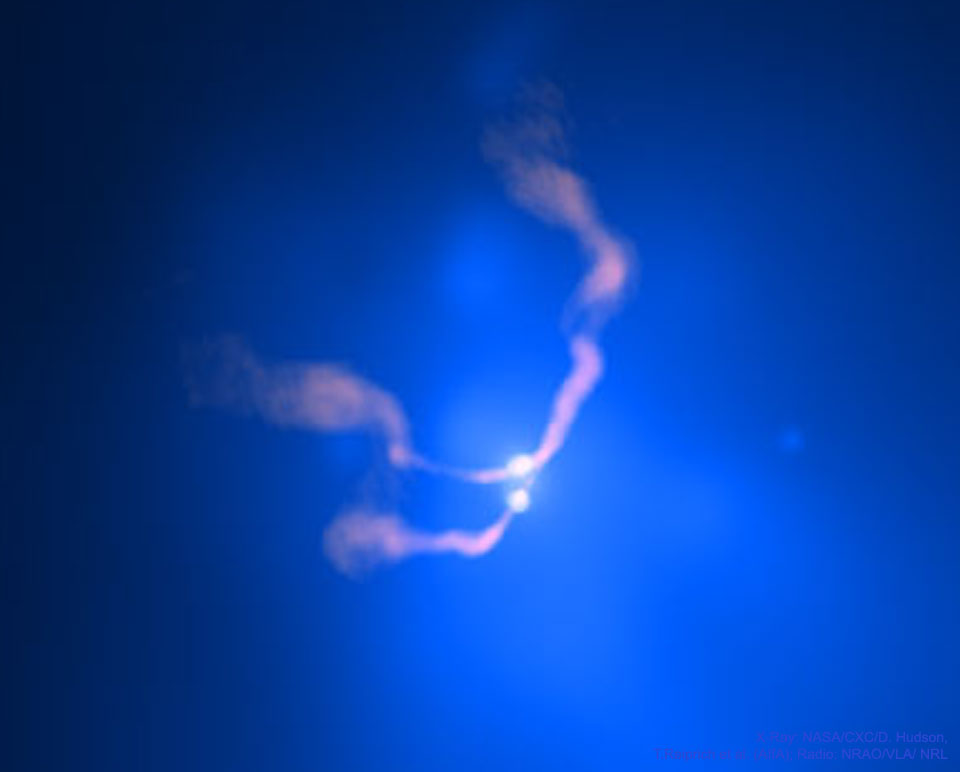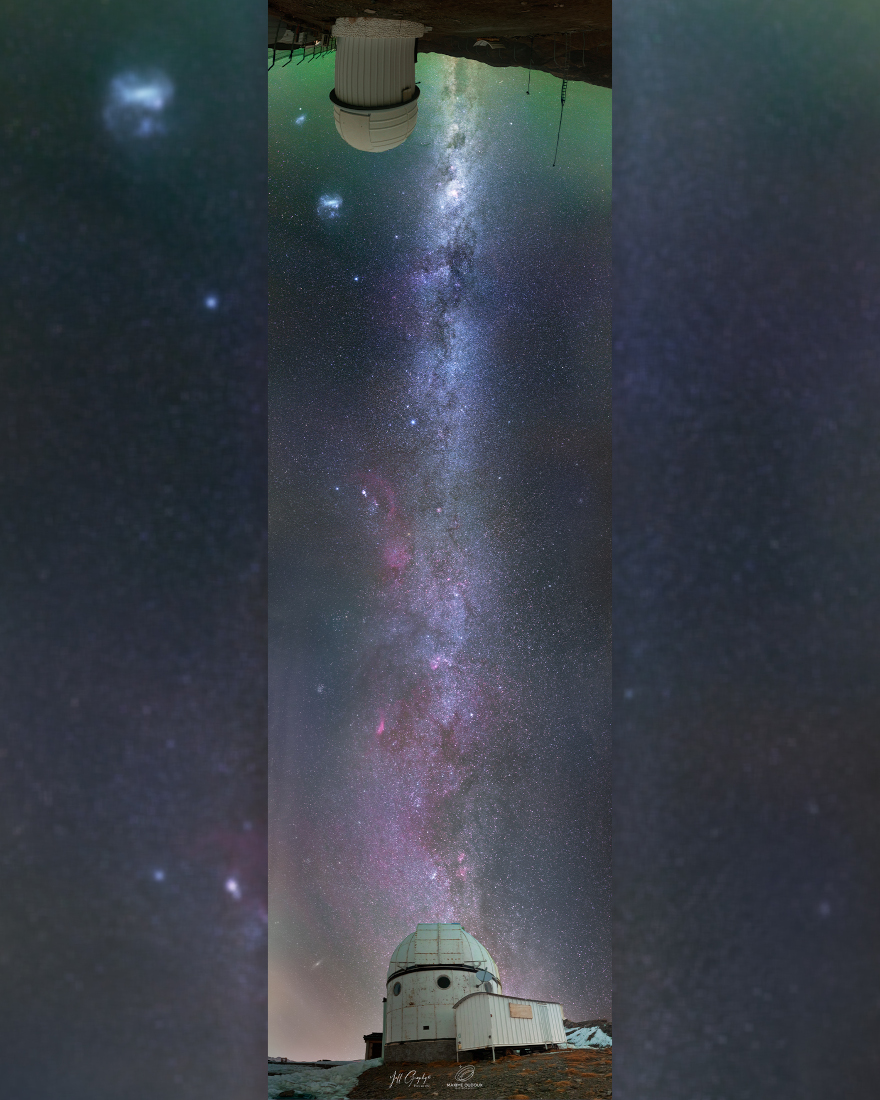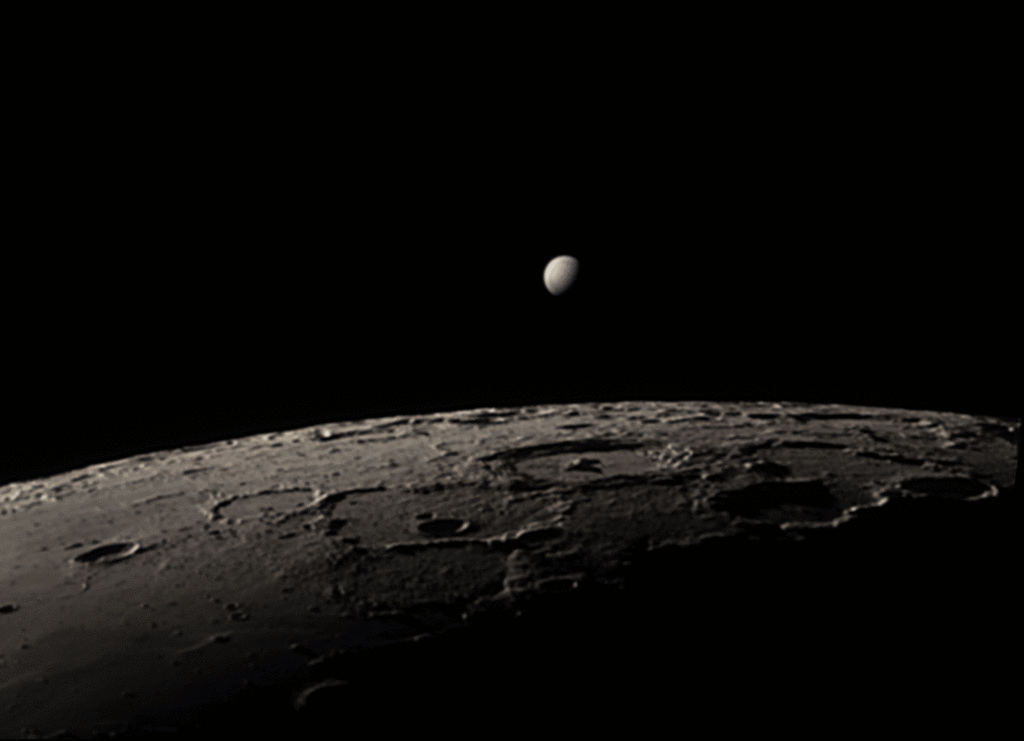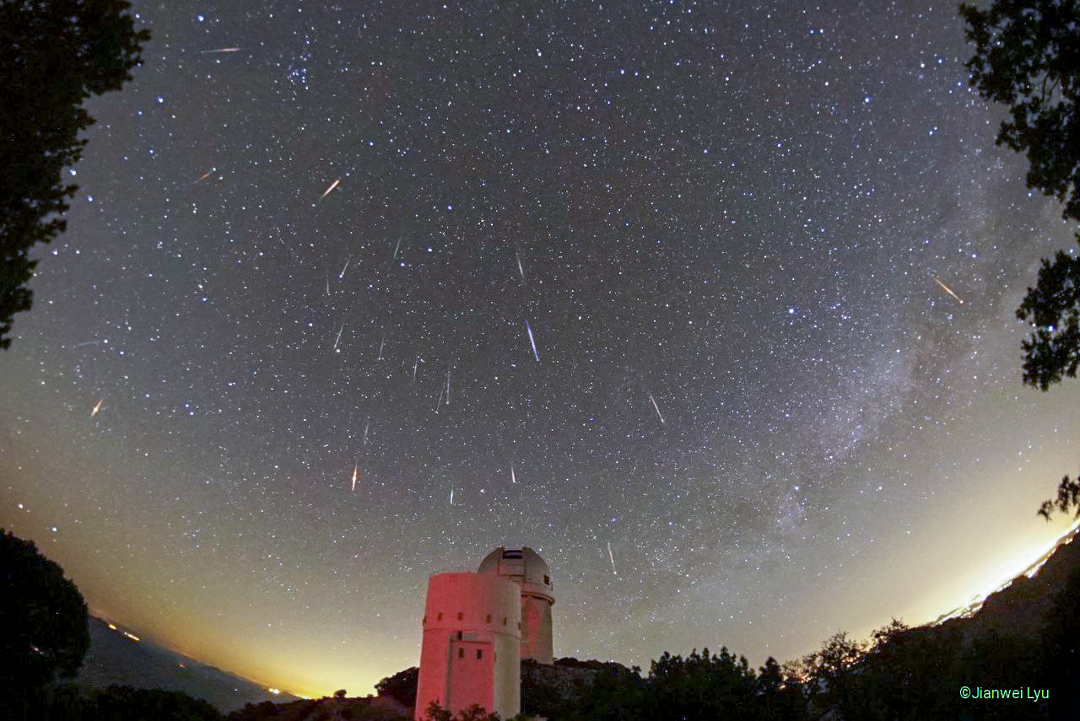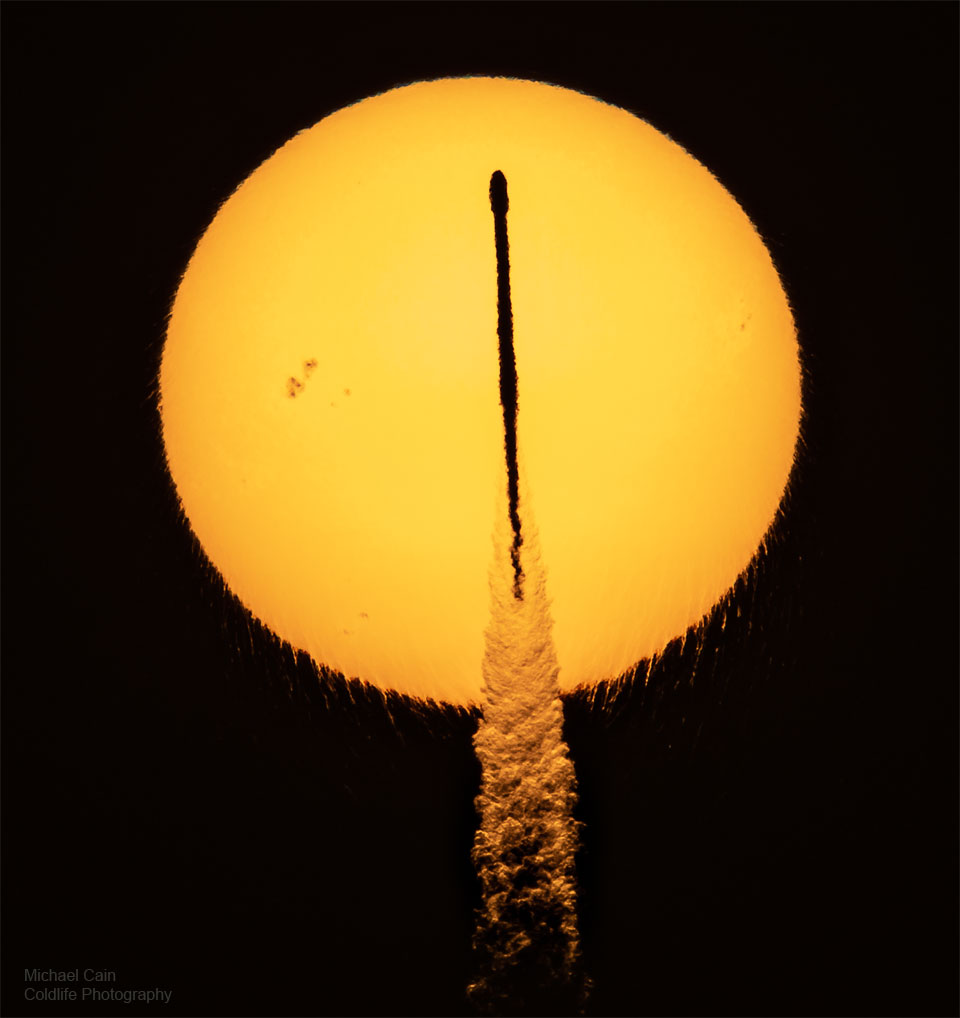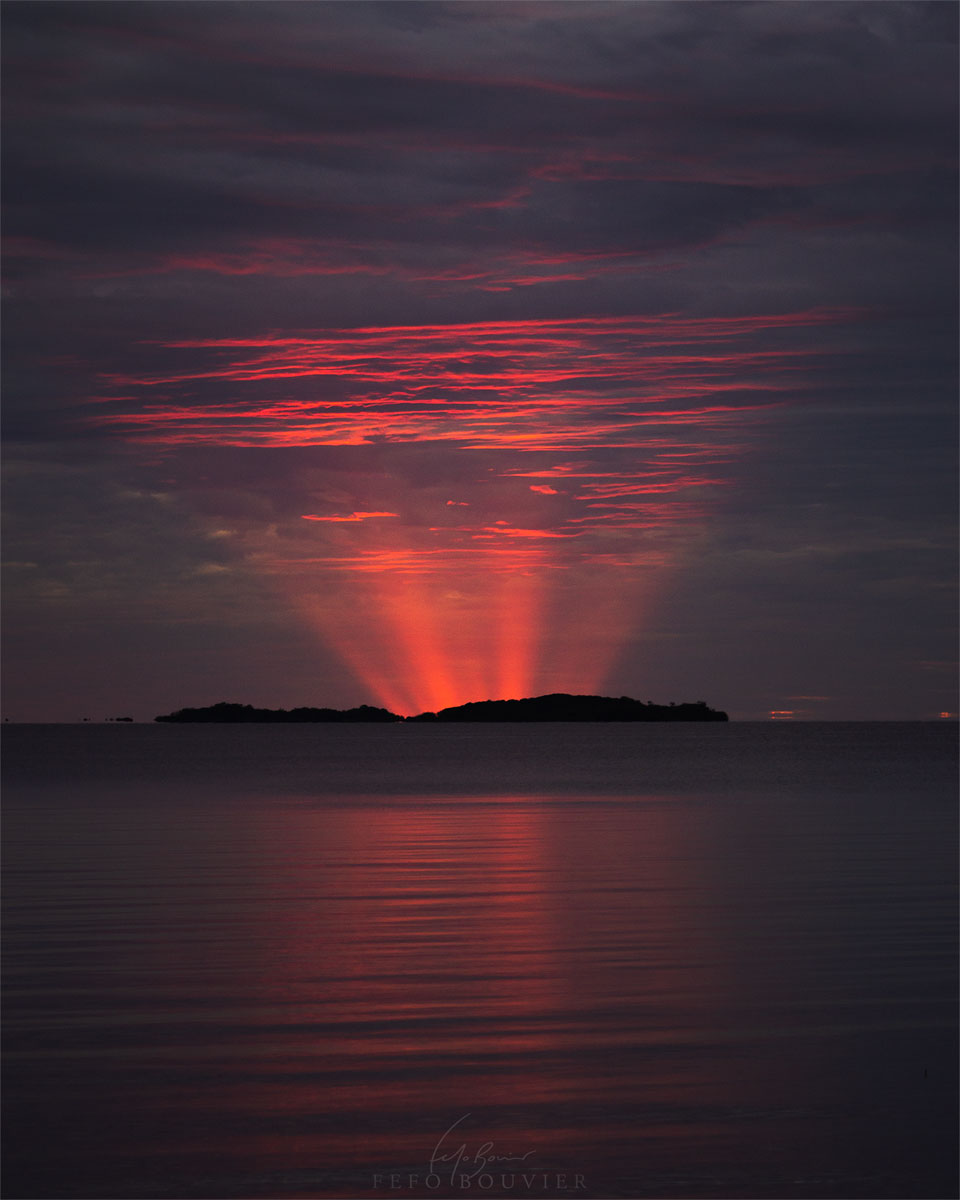Nombre total de pages vues
05/06/2022
PHOTOGRAPHIE - Milky Way fascination
ASTRONOMY - Two Black Holes Dancing in 3C 75
2022 June 5
Image Credit: X-Ray: NASA/CXC/D. Hudson, T. Reiprich et al. (AIfA); Radio: NRAO/VLA/ NRL
Explanation: What's happening at the center of active galaxy 3C 75? The two bright sources at the center of this composite x-ray (blue)/ radio (pink) image are co-orbiting supermassive black holes powering the giant radio source 3C 75. Surrounded by multimillion degree x-ray emitting gas, and blasting out jets of relativistic particles the supermassive black holes are separated by 25,000 light-years. At the cores of two merging galaxies in the Abell 400 galaxy cluster they are some 300 million light-years away. Astronomers conclude that these two supermassive black holes are bound together by gravity in a binary system in part because the jets' consistent swept back appearance is most likely due to their common motion as they speed through the hot cluster gas at about 1200 kilometers per second. Such spectacular cosmic mergers are thought to be common in crowded galaxy cluster environments in the distant universe. In their final stages, the mergers are expected to be intense sources of gravitational waves.
04/06/2022
ASTRONOMY - Tau Herculids from Space
2022 June 4
Image Credit & Copyright: Zhuoxiao Wang, Yangwang-1 Space Telescope, Origin.Space
Explanation: On May 31 tens of parallel meteor streaks were recorded in this 8 degree wide field of view of planet Earth's limb from space. The image is one of a series of 5 minute long observations by the orbiting Yangwang-1 space telescope. It was captured at 03:43 UT, near the peak of the Tau Herculid meteor shower. As predicted, the meteor shower was an active one this year, caused as Earth swept through a relatively dense stream of debris from disintegrating Comet 73P/Schwassmann-Wachmann 3, but was lacking bright meteors. Nearly all of the Tau Herculid meteors in the Yangwang-1 image are too faint to be detected by groundbased instruments. But on that date patient earthbound skywatchers under clear skies still enjoyed a memorable showing of the Tau Herculids.
03/06/2022
ASTRONOMY - A 10,000 Kilometer Galactic Bridge
2022 June 3
Image Credit & Copyright: Maxime Oudoux, Jean-Francois GELY
Explanation: With this creative astro-collaboration you can follow the plane of our Milky Way Galaxy as it bridges northern and southern hemisphere skies. To construct the expansive composite nightscape, skies over Observatorio El Sauce in Chile (top) were imaged on the same date but 6 hours later than the skies over the Saint-Veran observatory in the French Alps. The 6 hour time-lag allowed Earth's rotation to align the Milky Way above domes at the two sites. All exposures were made with similar cameras and lenses mounted on simple tripods. A faint greenish airglow is visible in the dark Chilean sky that also features the Large and Small Magellanic Clouds near the observatory dome. In the French Alps light pollution is apparent, but the distant Andromeda Galaxy can still be spotted near the horizon in the northern night. On planet Earth the two observatories are separated by about 10,000 kilometers.
02/06/2022
ASTRONOMY - Lunar Occultation of Venus
2022 June 2
Image Credit & Copyright: Quentin Gineys
Explanation: On May 27 Venus rose as the morning star, near the waning crescent Moon in a predawn sky already full of planets. It was close on the sky to the Moon's crescent and a conjunction of the second an third brightest celestial beacons were enjoyed by skygazers around the world. But seen from locations along a track through southeast Asia and the Indian Ocean the Moon actually passed in front of Venus in a lunar occultation. In this animated gif the 75 percent illuminated disk of Venus approaches and just begins to disappear behind the sunlit southwestern lunar limb. The telescopic frames used to construct it were captured from Reunion Island in the Indian Ocean around 4:50am local time, with the Moon and Venus very close to the eastern horizon. At the time Venus was over 180 million kilometers from Reunion Island, compared to a lunar distance of a mere 400 thousand kilometers or so. About 50 minutes later Venus emerged from behind the Moon.
01/06/2022
ASTROPHOTOGRAPHIE - Voie lactée dans un ciel limpide
ASTRONOMY - Tau Herculids Meteors over Kitt Peak Telescopes
2022 June 1
Image Credit & Copyright: Jianwei Lyu (Steward Obs., U. Arizona)
Explanation: It wasn't the storm of the century -- but it was a night to remember. Last night was the peak of the Tau Herculids meteor shower, a usually modest dribble of occasional meteors originating from the disintegrating Comet 73P/Schwassmann-Wachmann 3. This year, calculations showed that the Earth might be passing through a particularly dense stream of comet debris -- at best creating a storm of bright meteors streaking out from the constellation of Hercules. What actually happened fell short of a meteor storm, but could be called a decent meteor shower. Featured here is a composite image taken at Kitt Peak National Observatory in Arizona, USA accumulated over 2.5 hours very late on May 30. Over that time, 19 Tau Herculids meteors were captured, along with 4 unrelated meteors. (Can you find them?) In the near foreground is the Bok 2.3-meter Telescope with the 4.0-meter Mayall Telescope just behind it. Next year, the annual Tau Herculids are expected to return to its normal low rate, with the next active night forecast for 2049.
31/05/2022
ASTRONOMY - Rocket Transits Rippling Sun
2022 May 31
Image Credit & Copyright: Michael Cain
Explanation: The launch of a rocket at sunrise can result in unusual but intriguing images that feature both the rocket and the Sun. Such was the case last month when a SpaceX Falcon 9 rocket blasted off from NASA's Kennedy Space Center carrying 53 more Starlink satellites into low Earth orbit. In the featured launch picture, the rocket's exhaust plume glows beyond its projection onto the distant Sun, the rocket itself appears oddly jagged, and the Sun's lower edge shows peculiar drip-like ripples. The physical cause of all of these effects is pockets of relatively hot or rarefied air deflecting sunlight less strongly than pockets relatively cool or compressed air: refraction. Unaware of the Earthly show, active sunspot region 3014 -- on the upper left -- slowly crosses the Sun.
30/05/2022
ASTRONOMY - Red Crepuscular Rays from an Eclipse
2022 May 30
Image Credit & Copyright: Fefo Bouvier
Explanation: What's happening behind that island? Things both expected and unexpected. Expected, perhaps, the pictured rays of light -- called crepuscular rays -- originate from the Sun. Unexpected, though, the Sun was being partially eclipsed by the Moon at the time -- late last month. Expected, perhaps, the Sun's rays are quite bright as they shine through gaps in below-horizon clouds. Unexpected, though, the crepuscular rays are quite red, likely the result an abundance of aerosols in Earth's atmosphere scattering away much of the blue light. Expected, with hope, a memorable scene featuring both the Moon and the Sun, superposed. Unfortunately, from this location -- in Uruguay looking toward Argentina -- clouds obscured the eclipse -- which wasn't completely unexpected. However, after packing up to go home, the beauty of bright red crepuscular rays emerged -- quite unexpectedly. Oh -- and that island on the horizon -- it's really two islands.
29/05/2022
MERVEILLEUX MONDE SOUS-MARIN - L'atoll de Fakarava, dans l'archipel des Tuamotu
© Photographe Alexis Rosenfeld
ASTRONOMY - Sunset Solstice over Stonehenge
2025 December 22 Sunset Solstice over Stonehenge Image Credit & Copyright: English Heritage , Josh Dury Explanation: Yesterday the Su...
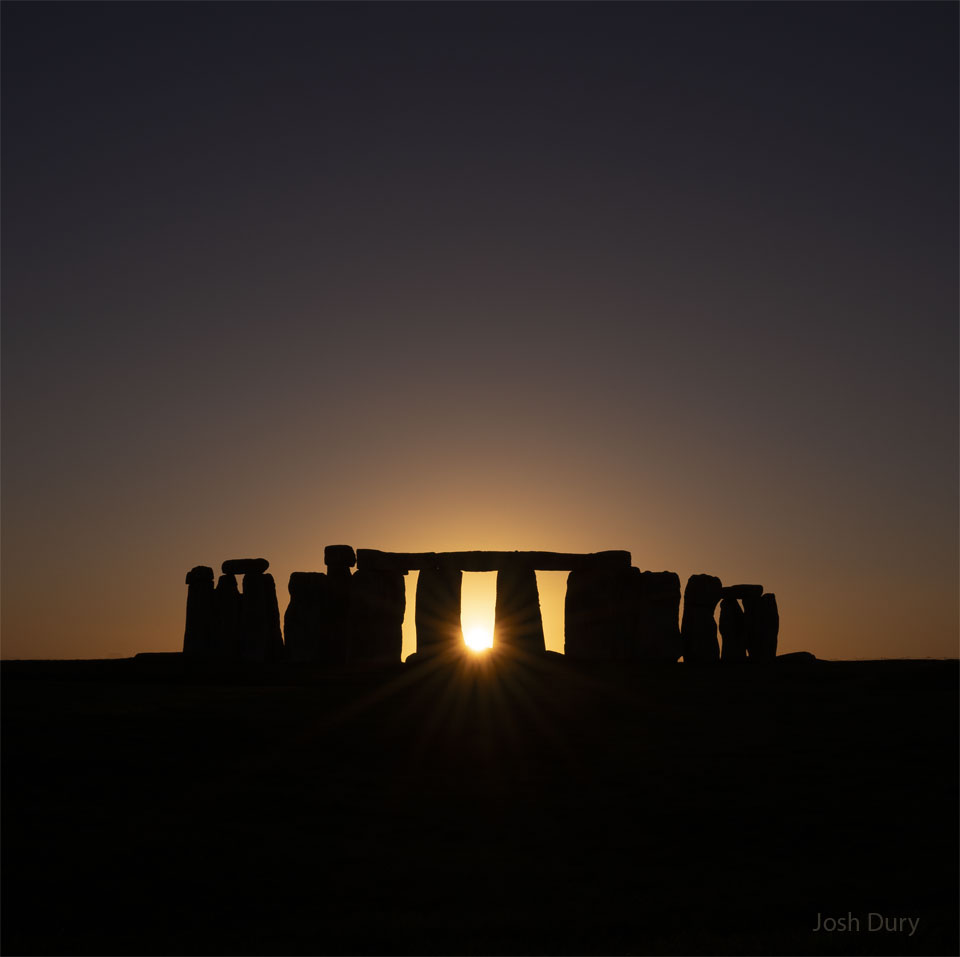
-
2022 September 26 All the Water on Planet Earth Illustration Credit: Jack Cook, Adam Nieman, Woods Hole Oceanographic Institution ; Data ...
-
2025 May 11 The Surface of Venus from Venera 14 Image Credit: Soviet Planetary Exploration Program , Venera 14 ; Processing & Copyri...

